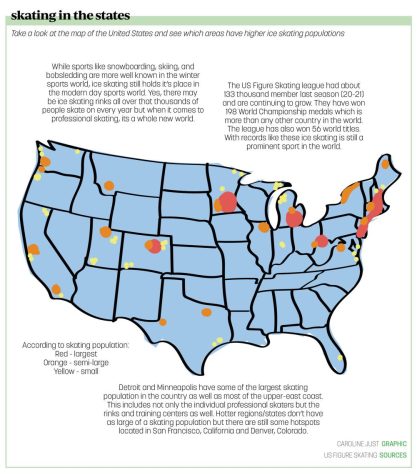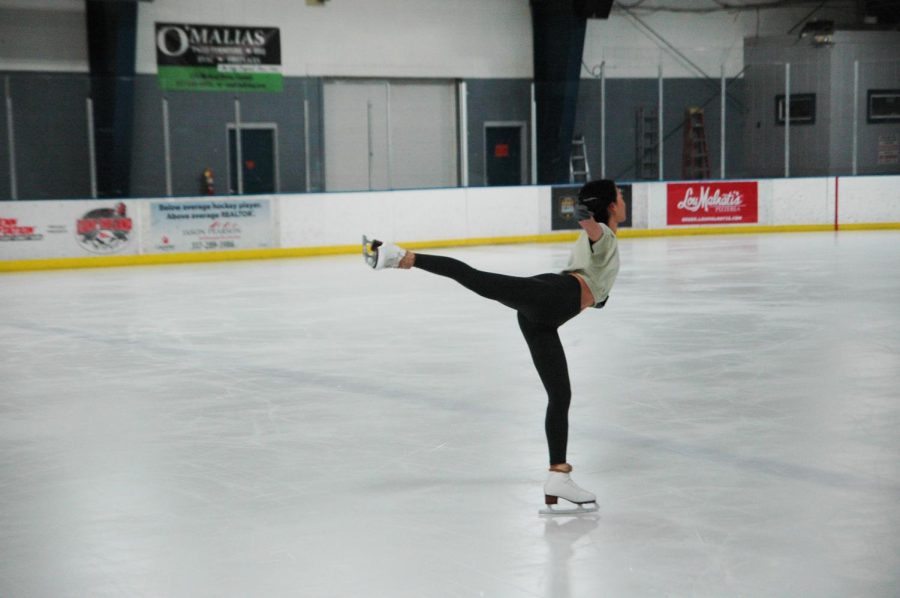When sophomore Grace Nie started figure skating, she fell in love with the sport.
“I started (figure skating) when I was in second grade, when I was 8, and I just really fell in love with the sport, and I just like doing it.”
However, Nie said that there are a lot of challenges to competing in a winter sport such as figure skating, including high participation costs.
“(Figure skating) is a really expensive sport, and as you get to a higher level, you have to buy your blades and boots separately, and each of them can cost up to $500 dollars or more depending on your level. In addition there is a lack of accessibility as you have to go to an ice rink, and there aren’t a lot of ice rinks.”
Nie is not alone. According to Money, Olympic figure skating is one of the most expensive sports to compete in, with costs upwards from $35,000 annually.
Kris May, the 1991 Women’s Speed-Skating National Champion said via email that participating in winter sports can be very expensive.
“I would not have been able to participate without sponsorship. It was difficult, but I worked very hard to gain sponsorship from a local conglomerate of companies led by frontier trucking, and then was able to secure sponsorship from the Indiana sports corporation. Once I had succeeded in several competitions. I also worked at Wendy’s on the fast food line when I first moved to Boulder, Colorado for summer training with my first coach, in order to support myself and stay there.”
Nie said she faces challenges balancing figure skating into her schedule, and practicing off the ice.
“The biggest (challenge) is that my practices are all in the morning during the school days, so I skate from 6 to 8 before school, so I have to make sure that I manage my time to sleep at a reasonable time. There are a lot of things that I cannot practice while I am off the ice, so you have to get creative and come up with ways to train outside the ice, while sports like basketball, you can get a net and practice on your own. For figure skating you have to do different exercises that might not translate to what you do on ice.”
May also said that she faced accessibility issues when practicing speed-skating.
“When I first started, there was only two practice times a week. Therefore I had to do what’s called dry skating, and or training on a slide board. That is now a popular exercise piece of equipment, but at the time was really only used by speed skaters. Obviously I had to move if I wanted to compete in outdoor speedskating as there were no are very few indoor long tracks at the time. I spent a lot of time in Butte, Montana, Calgary, Canada, and Boulder, Colorado.”
Sophie Ramos, sophomore hockey player and former figure skater, said that figure skating has less opportunities compared to other sports such as hockey.
“For hockey (compared to figure skating), there are a lot more opportunities to (play for) a college team, and there are a lot more team programs, and at the (skating) rink, there are more things dedicated to hockey to get young kids involved in the sport, while in figure skating, there is less funding and less coaches.”
In addition, Nie said that figure skating has a limited number of resources and coaches.
“(Coaching) is a factor as well for the accessibility challenges with figure skating. Since figure skating is a dying sport, all the coaches and judges at competitions are old, and that can influence (the amount of coaches), since there is a dwindling number of coaches.”
Nie said that the technical aspect of figure skating makes figure skating less common.
“I think that more people need to be interested in figure skating (for it to be more common). Currently there is a lot of focus on the jumps and the technical aspects of it, and as a (someone watching) you don’t really understand what the difference in the difficulty levels is, while if they focus on making (figure skating) more interesting and accessible to the public, like building more ice rinks.”


































![AI in films like "The Brutalist" is convenient, but shouldn’t take priority [opinion]](https://hilite.org/wp-content/uploads/2025/02/catherine-cover-1200x471.jpg)










































![Review: “The Immortal Soul Salvage Yard:” A criminally underrated poetry collection [MUSE]](https://hilite.org/wp-content/uploads/2025/03/71cju6TvqmL._AC_UF10001000_QL80_.jpg)
![Review: "Dog Man" is Unapologetically Chaotic [MUSE]](https://hilite.org/wp-content/uploads/2025/03/dogman-1200x700.jpg)
![Review: "Ne Zha 2": The WeChat family reunion I didn’t know I needed [MUSE]](https://hilite.org/wp-content/uploads/2025/03/unnamed-4.png)
![Review in Print: Maripaz Villar brings a delightfully unique style to the world of WEBTOON [MUSE]](https://hilite.org/wp-content/uploads/2023/12/maripazcover-1200x960.jpg)
![Review: “The Sword of Kaigen” is a masterpiece [MUSE]](https://hilite.org/wp-content/uploads/2023/11/Screenshot-2023-11-26-201051.png)
![Review: Gateron Oil Kings, great linear switches, okay price [MUSE]](https://hilite.org/wp-content/uploads/2023/11/Screenshot-2023-11-26-200553.png)
![Review: “A Haunting in Venice” is a significant improvement from other Agatha Christie adaptations [MUSE]](https://hilite.org/wp-content/uploads/2023/11/e7ee2938a6d422669771bce6d8088521.jpg)
![Review: A Thanksgiving story from elementary school, still just as interesting [MUSE]](https://hilite.org/wp-content/uploads/2023/11/Screenshot-2023-11-26-195514-987x1200.png)
![Review: "When I Fly Towards You", cute, uplifting youth drama [MUSE]](https://hilite.org/wp-content/uploads/2023/09/When-I-Fly-Towards-You-Chinese-drama.png)
![Postcards from Muse: Hawaii Travel Diary [MUSE]](https://hilite.org/wp-content/uploads/2023/09/My-project-1-1200x1200.jpg)
![Review: "Ladybug & Cat Noir: The Movie," departure from original show [MUSE]](https://hilite.org/wp-content/uploads/2023/09/Ladybug__Cat_Noir_-_The_Movie_poster.jpg)
![Review in Print: "Hidden Love" is the cute, uplifting drama everyone needs [MUSE]](https://hilite.org/wp-content/uploads/2023/09/hiddenlovecover-e1693597208225-1030x1200.png)
![Review in Print: "Heartstopper" is the heartwarming queer romance we all need [MUSE]](https://hilite.org/wp-content/uploads/2023/08/museheartstoppercover-1200x654.png)




